Mgahinga Gorillas – Information about Mountain Gorillas of Mgahinga National Park, Facts, Gorilla trekking Guide, History and Travel Tips
Mgahinga Gorillas are the prime attraction found within Uganda’s smallest National Park, set in the south-west of the country. The beautiful Mgahinga Gorilla National Park safeguards the Ugandan side of the Virunga Mountain slopes, a dramatic stretch of eight free-standing active and dormant Volcanoes that sprawl along the border with the Democratic Republic of Congo and Rwanda.
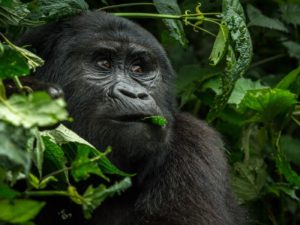 The most interesting thing about mountain gorillas that live within the Virunga Mountains range is that they pop in and out while taking temporary occupancy for several months at any of the countries in the stretch. The surprising migration of Hirwa Gorilla Group from Rwanda’s Volcanoes National Park to Uganda’s Mgahinga Gorilla National Park in 2019 is a good case in point.
The most interesting thing about mountain gorillas that live within the Virunga Mountains range is that they pop in and out while taking temporary occupancy for several months at any of the countries in the stretch. The surprising migration of Hirwa Gorilla Group from Rwanda’s Volcanoes National Park to Uganda’s Mgahinga Gorilla National Park in 2019 is a good case in point.
Mgahinga Gorillas are among the endangered primates that call the densely forested slopes of East-Central Africa home and are found in only three countries in the entire World. Therefore Mgahinga is one of the three National Parks that protect the heavily forested mountains in the remarkable Virunga Mountains. Other places to find mountain gorillas are Bwindi Impenetrable National Park (also in south-western Uganda), Virunga National Park in the Democratic Republic of Congo and Volcanoes National Park.
The natural habitat of Mgahinga Gorillas is marked by Sub-tropical or Tropical rainforests, occupying the spectacular Albertine Rift Montane forests of the wide-ranging Virunga Mountains within elevations that range from 2200 to 4500 meters above sea level. All in all, these Great Apes call the verdant and dense vegetation home.
Between 80 and 100 mountain gorillas freely roam around the 34 square kilometers of Mgahinga Gorilla National Park, although there is only one habituated gorilla group visited by visitors during gorilla safaris.
History about Mgahinga Gorillas
Little was said about Mgahinga Gorillas until between 1930s and 1950 when the naturally forested area that was known to be a Forest Reserve was partially turned into crop fields, especially within the lower elevations. Biological surveys began in about 1989 and because of this, wire snare set by poachers were demolished, the Rangers were trained and trees later planted. The local community members that occupied the area were later evacuated/or transferred to surrounding areas of the Protected Area even through the early 1990s.
The Mgahinga Gorilla National Park was established in 1991, the same year Bwindi Impenetrable National Park was gazetted. However, even after the official protection of this Protected Area didn’t completely shield it from conservation challenges, although a couple of strides have been achieved throughout the years. The M23 Movement (a notorious Congolese Rebel Group) surrendered within Mgahinga Gorilla National Park in November 2013 after defeat by the Congolese Army.
Gorilla Groups in Mgahinga Gorilla National Park
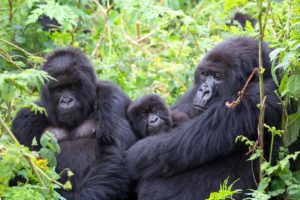 Only one habituated gorilla group calls Mgahinga Gorilla National Park home and can be visited by a maximum of 8 visitors per day. The Group is known as “Nyakagezi”, named after the location in the Park where its members were first spotted by trackers. While it was always known for being mobile (always on the move) to the neighboring countries of Democratic Republic of Congo and Rwanda, it is now believed to have permanently settled for several years. For this reason, visitors can now get the chance to trek gorillas and spend time with them although permits have to be booked several months in advance.
Only one habituated gorilla group calls Mgahinga Gorilla National Park home and can be visited by a maximum of 8 visitors per day. The Group is known as “Nyakagezi”, named after the location in the Park where its members were first spotted by trackers. While it was always known for being mobile (always on the move) to the neighboring countries of Democratic Republic of Congo and Rwanda, it is now believed to have permanently settled for several years. For this reason, visitors can now get the chance to trek gorillas and spend time with them although permits have to be booked several months in advance.
Habituation of Nyakagezi Gorilla Group started the same year the Park was gazetted (in 1991) and was opened for trekking three years later. It was under the headship of Bugingo at the time of habituation but was later taken-over by Mark. It is a common phenomenal among gorilla groups that when another silverback takes over leadership, the deposed head leaves the group and dies a loner. This wasn’t the case with Bugingo who remained within the family and is said to be about 55 years.
Mark the silverback is assisted by Mafia and the group is presently made up of 10 individuals that include 5 silverbacks (Bugingo, Mark (the head), Mafia, Ndugutse and Rukundo), 2 adult females (Nyiramwiza and Nshuti) and 3 infants that include (Mutagamba, Fred and Nshuti’s baby.
Nyakagezi Gorilla Group occupies the lower slopes of Virunga Mountains within the lowland forests hence making it an easy-to-trek gorilla group unlike Bwindi Gorillas that live in the higher and steep slopes thus difficult-to-trek.
Characteristics of Mgahinga Gorillas
Mgahinga Gorillas belong to the “mountain gorilla” sub-specie of Eastern gorillas and are one of the largest living Primate species on Earth. They are also referred as Gorilla beringei beringei and are categorized as “endangered” under IUCN Red List with their World’s population estimated to be about 1080 individuals.
Mgahinga Gorillas live in the Virunga Conservation Area (that also encompasses Volcanoes National Park of Rwanda and Virunga National Park of the Democratic Republic of Congo. These Giant Apes are characterized by muscular arms, wide chests as well as huge hands and feet. Because these creatures occupy high altitude areas with colder temperatures, their fur is longer and thicker than all the remaining gorilla sub-species to allow then comfortable live in their natural environment.
A fully-grown mountain gorilla weighs between 130 and 220 kilograms and measures 1-2 meters fall. These primates are herbivorous and their diet typically comprises of pulp, plant roots, tree barks, succulent leaves, bamboo shoots, stems, vines, wild celery and fruits of different plant species.
The natural habitat of Mgahinga Gorillas is thick rainforests, mixed forest, Bamboo forest as well as Sub-Alpine grassland on the volcanic peaks. On life span, they are said to live up to an average of 40 years, although some have observed to have lived for up to 50 years.
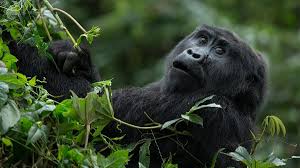 Their gestation period is 8.5 months, after which one live baby is born (sometimes twins) weighing between 1.4 and 1.8 kilograms (about half the average weight of a human baby). These creatures however grow faster than humans, reaching maturity at 10 years for females and 12 years for males. While mothers are the primary caretakers, siblings and silverbacks usually offer a helping hand in raising the baby. Baby gorillas are surprisingly not born with teeth, like humans and entirely depend on mother’s breast milk until 2 years, although solid foods are slowly introduced in the course of their growth until they are able to depend on other foods.
Their gestation period is 8.5 months, after which one live baby is born (sometimes twins) weighing between 1.4 and 1.8 kilograms (about half the average weight of a human baby). These creatures however grow faster than humans, reaching maturity at 10 years for females and 12 years for males. While mothers are the primary caretakers, siblings and silverbacks usually offer a helping hand in raising the baby. Baby gorillas are surprisingly not born with teeth, like humans and entirely depend on mother’s breast milk until 2 years, although solid foods are slowly introduced in the course of their growth until they are able to depend on other foods.
Mgahinga Gorillas are said to be highly intelligent and use different tools like other Apes and use several vocalizations for communication.
Gorilla Trekking in Mgahinga Gorilla National Park
Walks from the Tented Camps/Safari Lodges to Ntebeko Visitor Center usually start between 6:30 and 7:00am, followed by registration and briefing that lasts 30 to 45 minutes. This is followed by allocation of visitors to the only habituated gorilla group, limited to 8 persons.
The limit on number of people visiting Mgahinga Gorillas is done to ensure safety of the Giant Apes from contracting airborne pathogens in addition to increasing chances of sighting, since it is believed that bigger groups usually scare away these gentle and timid creatures.
Treks begin by 8:00am and go through the slopes of Virunga Mountains for half an hour to almost three hours when evidence of gorilla nests (for the night before) start being noticeable. This means the gorillas are close by and therefore it will take another one hour to finally make contact with the Giant Apes. When contacts are made, you will notice slow movements within the thick vegetation as the primates get close and slowly come out.
When the Giant Apes finally emerge from the dense vegetation, you will clearly have a view of their daily routines hence a truly jaw-dropping experience to behold. Visitors have a total of one hour to spend with the mountain gorillas after contacts are made.
Best time of the year to go gorilla trekking in Mgahinga Gorilla National Park
While Mgahinga Gorilla National Park is open throughout the year, the best time of the year to go gorilla trekking is the drier season from June to September as well as December to February. During these months, forest paths/trails are more favorable to maneuver through as well as spending time with the mountain gorillas being pleasant, given the fact that chances of receiving rain is almost at zero. Drier forest floor means it is easier to walk and hike the slopes of Virunga Mountains and because most visitors prefer this time of the year, gorilla trekking permits are difficult to acquire at short notice hence advance booking is recommended.
The wet season-March to May and October to November receive heavy downpours and forest paths/hiking trails become challenging and Park roads’ conditions become so bad thus inaccessible.
Where to stay within Mgahinga National Park after Gorilla Trekking
There are several sleeping options in Mgahinga Gorilla National Park after gorilla trekking adventures and they range from luxury to the more affordable budget options. These places are;
Mount Gahinga Lodge
Situated at the main entrance of Mgahinga Gorilla National Park, Mount Gahinga Lodge is a luxurious option that sits on the sun terrace that overlooks the magnificent Virunga Mountains. It features 6 Bandas made of Stone walls and Papyrus roof, each named after a Virunga Mountain and offering en-suit facilities. Guests here are guaranteed of enjoying vast dining areas, open-space lounge, terrace, cozy fireplace, massage room and gift shop. Three of the Bandas have double beds while the remaining ones feature twin beds with common room amenities being shower, flush toilet, cold/hot running water, wash basins in addition to Private veranda.
Other places to stay in this small National Park are Mucha Hotel in Kisoro, Amajambere Iwacu Community Rest Camp, Travelers’ Rest Hotel Kisoro, Mgahinga Rest Camp, Kisoro Tourist Hotel and Mutanda Lake Resort for visitors who plan to add the spectacular Lake Mutanda.
How many visitors are allowed to trek Mgahinga Gorillas?
A maximum of 8 visitors are allowed to trek Mgahinga Gorillas and this principle/rule is strictly implemented without fail. There are a number of reasons why the number of people trekking a particular gorilla family is limited to eight (8) and these include the need to reduce behavioral changes because it is believed that large crowds can stress or inconvenience the Giant Apes as they go about their day-to-day activities.
The limit is also placed to reduce the risk of exposing the endangered Giant Apes to airborne pathogens, resulting from tourist visits and given the 98.2% relatedness of their DNA to humans, they are susceptible to several human diseases such as cough, flue and measles among others.
Age limit for trekking Mgahinga Gorillas
The age limit for trekking Mgahinga Gorillas is 15 years and there are several reasons for this limit. Young children are said to be unpredictable and cannot remain calm, in case of a silverback charging. In most cases when visitors make contact with the habituated gorilla family, the dominant silverback has to make sure that visitors aren’t a threat to his group members and in so doing, he charges by beating the chest. A child may not restrain from screaming and running away, which might irritate the silverback gorilla more.
Another rationale of setting an age limit for trekking Mgahinga Gorillas is the fact that children are the main carriers of communicable diseases especially flue, cough and measles which also affect the Giant Apes.
Generally, gorilla trekking is strenuous which requires participants to be physically fit, and a child of 5, 7 or 10 years is possibly physically weak to take on the mountainous slopes for the mountain gorillas. Treks are likely to be slowed down if they involve young children.
Gorilla Trekking Permits for Mgahinga Gorillas
Gorilla trekking permits for Mgahinga Gorillas cost $700 per person for foreign resident visitors, $600 per person for foreign non-resident tourists and Uganda Shillings 250,000 per person for East African resident visitors, issued by Uganda Wildlife Authority. The permits guarantee entry into the jungle to search and spend one hour with the mountain gorillas, services of a Park Ranger/guide and security through the Park (ensured by the armed Ranger). Because there is only one habituated gorilla group in Mgahinga Gorilla National Park, only 8 permits are issued per day and have to be booked at least 4-6 months before the trekking date.
How to obtain Gorilla Trekking Permits for Mgahinga Gorilla National Park
Permits for trekking Mgahinga Gorillas can be obtained directly from Uganda Wildlife Authority or via credible tour operators. It is important to first check availability of permits then making booking within 4-6 months in advance. Send an email directly to Uganda Wildlife Authority or reach at their Offices physically.
Go for the less stressful option of booking via credible tour operator by sending inquiries with intended trekking date to check availability, then send your passport details (age, name and passport number) and initial deposit. The permit will then be booked on your behalf and a scanned copy of receipt sent to confirm payment. The Tour Operator will ease the entire planning process of the gorilla safari by planning for most convenient place of lodging, transportation by comfortable 4WD Safari Vehicle.
Gorilla Filming in Mgahinga National Park
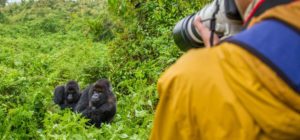 Mgahinga National Park is one of the few places that offer gorilla filming in the wild and to start your adventure, you need to understand how to get the required media accreditation, acquire filming permits from Uganda Wildlife Authority, how to book gorilla permits for Mgahinga Gorillas and how to clear filming equipment at immigration.
Mgahinga National Park is one of the few places that offer gorilla filming in the wild and to start your adventure, you need to understand how to get the required media accreditation, acquire filming permits from Uganda Wildlife Authority, how to book gorilla permits for Mgahinga Gorillas and how to clear filming equipment at immigration.
Before being allowed to film gorillas in the wild, you must have a media accreditation, obtained from Uganda media Council and are charged based on the duration. Media accreditation cards for one month cost $175 per person, for 6 months cost $225 per person while for two years cost $325 per person. Requirements for applying are scanned passport as well as recent passport-sized photo, and it takes 2-3 working days to process for your media accreditation card.
The gorilla filming permit is required and usually costs 40% of the gorilla permit price and 10% monitoring fees. You will then be issued a filming agreement by Uganda Wildlife Authority. Most importantly, don’t forget to book for your gorilla trekking permit (that costs $700 per person. Other crucial procedures for undertaking a memorable gorilla filming adventure in Mgahinga Gorilla National Park include clearance of filming equipment by immigration, booking for comfortable accommodation and transportation as well as showing up on time.
3 Amazing Things about Mgahinga Gorillas
Mgahinga Gorillas are said to be roamers that are always on the move across borders of Uganda, Rwanda and Democratic Republic of Congo, although they are said to have now settled.
Mgahinga Gorillas use a wide range of vocalizations for communicating, and these are cheat beating, loud grunts, hoots, and sometimes sign language as was discovered by animal behaviorists.
Don’t be intimidated by the massive size of Mgahinga Gorillas because they are generally shy, peaceful as well as gentle and not what is portrayed in films like King Kong.
How to book a Gorilla Safari to Mgahinga National Park
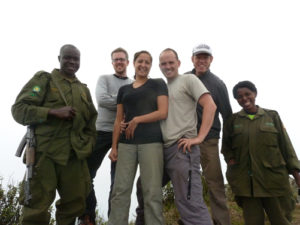 Having made up your mind to undertake a gorilla safari to Mgahinga National Park and even choosing the trekking date, find a credible tour operator. Afterwards, send your inquiry to the Company email or call to make your needs known. The Tour Operator gets back to you with different gorilla packages for Mgahinga and costing. If what is given is within your budget and personal interests, confirm the safari then make payments.
Having made up your mind to undertake a gorilla safari to Mgahinga National Park and even choosing the trekking date, find a credible tour operator. Afterwards, send your inquiry to the Company email or call to make your needs known. The Tour Operator gets back to you with different gorilla packages for Mgahinga and costing. If what is given is within your budget and personal interests, confirm the safari then make payments.
Getting to Mgahinga Gorillas
The stunning Mgahinga National Park is nestled within the south-west of Uganda and is part of the Virunga Conservation Area. Access to the Park is in two ways- Air or road. Tourists planning to use the latter should be prepared for 8-10 hours of driving through smooth tarred roads to Kisoro Town, then murram to the Park. For Air, scheduled flights are organized daily by Aerolink from Entebbe International Airport or Kajjansi Airstrip to Kisoro Airstrip then take only one hour on the road to the Gorilla Park.
Therefore, visiting Mgahinga Gorillas is one of the best adventures for primate fanatics and it’s from here that travellers get to learn about the history of Mgahinga Gorillas, their characteristics, how trekking tours are conducted, best time of the year to trek them, maximum number of people allowed to trek these gorillas and why a limit is places, how gorilla filming is done and how to book gorilla safari to the incredible Mgahinga National Park.

